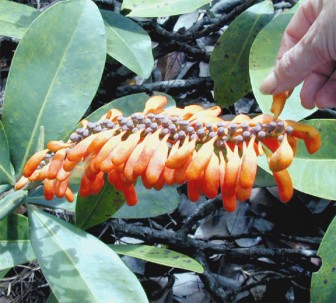Iwokrama boasts over 1,500 species of flowering plants (and counting). As you travel along the Iwokrama road or walk along the trails in the forest you are likely to come across many spectacular flowers, like the Norantea.
The Norantea guianensis is a shrub with bright orange to deep red ‘nectar pouches’ near the flowers and leathery leaves. It is of the Marcgraviaceae species and grows in South America. In its native habitat the plant is visited and pollinated by birds foraging for nectar. It is usually found in swampy forests on pegasse, and its bark or wood is said to have medicinal value in halting diarrhoea and vomiting, while the plant is said to be similarly useful employed on the body against fever.
![]() Rain forests are rich in biodiversity and are home to many different plants and animals as well as indigenous communities. Humans, even those who don’t live in the rain forest, rely on it for resources such as building materials (wood and lianas), medicine and fruits.
Rain forests are rich in biodiversity and are home to many different plants and animals as well as indigenous communities. Humans, even those who don’t live in the rain forest, rely on it for resources such as building materials (wood and lianas), medicine and fruits.

Rain forests also provide essential environmental services for life on earth; they create soil as well as prevent soil erosion, produce oxygen through photosynthesis, maintain clean water systems, and are a key defence against climate change.
The Iwokrama Rain Forest is 371,000 hectares, located in the heart of Guyana. Our mission is to develop strategies for conservation and sustainable development for local people in Guyana and the world at large. We are involved in timber, tourism and training. Come and visit us in the rain forest or at http://www .iwokrama.org.







